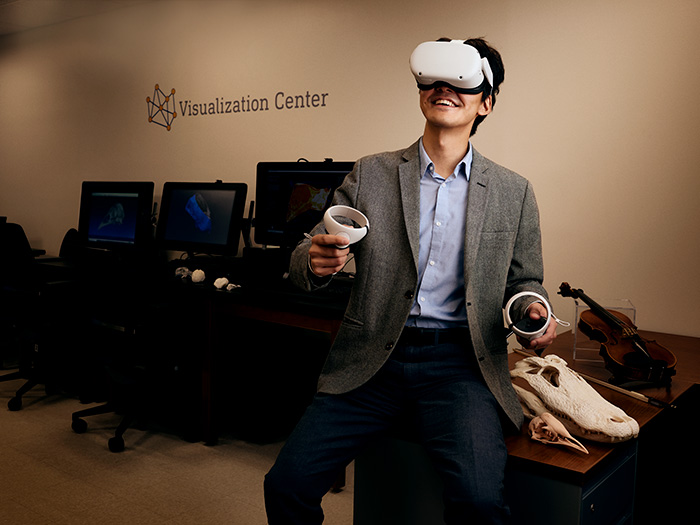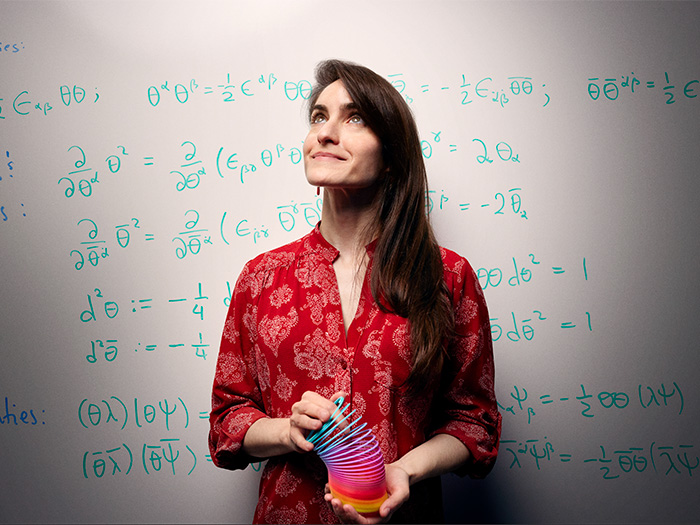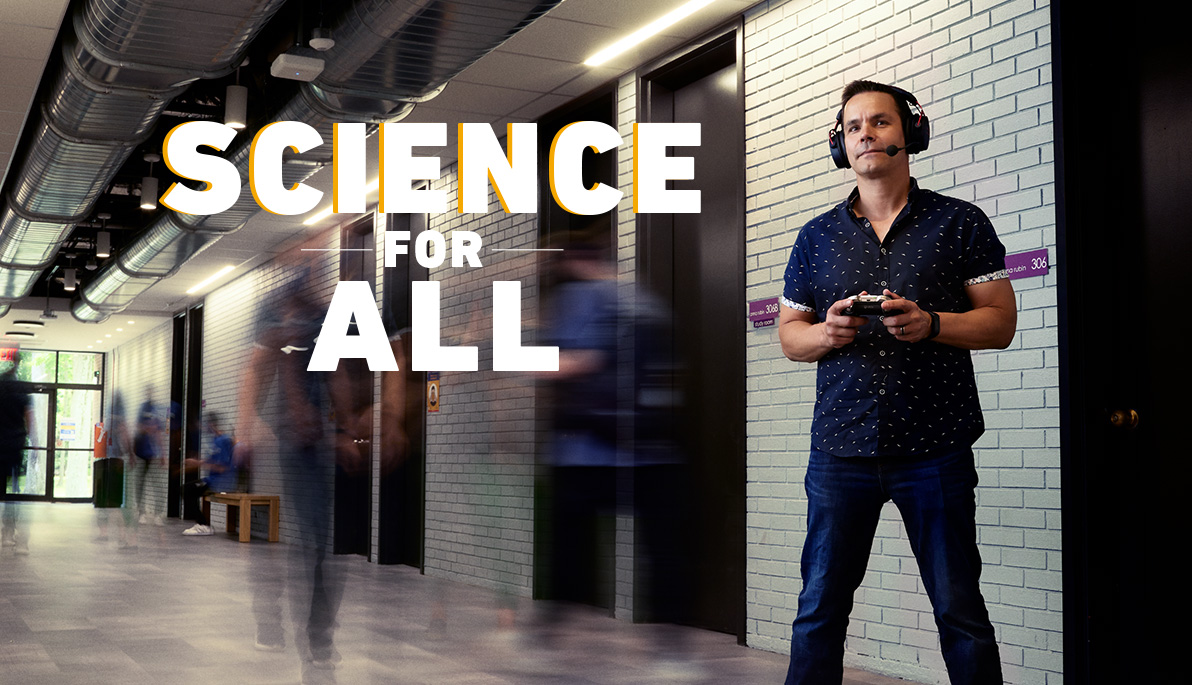News
Science for All
December 20, 2021
While William Shakespeare’s Hamlet is a requisite for most literature classes, students can easily get lost in the vernacular. On the other side of the academic spectrum— the sciences— understanding concepts in physics, biology, and anatomy can be equally as challenging.
To address the daunting task of engaging students in complicated subject matter, four New York Institute of Technology faculty members are leveraging creative approaches and drawing on improvisation, video games, and popular culture to teach their areas of expertise. They’ve also found ways to integrate these innovative methods into their research and scholarship.
Marrying the Virtual World with Science and Literature
Most people would not dare mention Shakespeare and video games in the same sentence. Not John Misak, assistant professor of humanities, who recently developed the game Perchance: An AR Hamlet Mystery (AR stands for augmented reality) with Kevin LaGrandeur, Ph.D., former New York Tech professor of English. After noticing his students’ lack of engagement with Hamlet during class, Misak saw a unique opportunity to take his passion for video games to the next level while enhancing his students’ in-class experience. He taught himself some basic coding and animation skills, then brought in undergraduate students from the College of Engineering and Computing Sciences to help integrate more advanced technology into his new-age approach to literature.
“We saw an opportunity to create a high-impact classroom exercise. Having theorized based on student sentiment toward Shakespeare, it was time to put our thoughts into practice. Perchance is the result of this desire to actively engage students in texts they often have an aversion to. Their response has been overwhelmingly positive,” he says.
In 2018, Misak and his team developed a beta test for students to experiment and provide feedback. Since then, a mystery component has been added and improvements have been made. “Students indicated a preference for a traditional game with AR sprinkled in,” he says.
Misak also has students collaborate on design, having them provide coding, writing, and graphic support. Ultimately, he wants students in New York Tech’s science technology, engineering, and math (STEM) majors to use these recognizable skills in his classes, another move that could help to remove the barriers created by preconceived notions about classic literature and students’ abilities to enjoy these works. “I see our work as a balance between traditional and cutting-edge technology. Our app is designed to encourage reading—not replace it.”
 Akinobu “Aki” Watanabe, Ph.D., Photographed by Rick Wenner.
Akinobu “Aki” Watanabe, Ph.D., Photographed by Rick Wenner.
Akinobu “Aki” Watanabe, Ph.D., assistant professor of anatomy in the College of Osteopathic Medicine, is also taking his research into the virtual realm. As part of a National Science Foundation (NSF) Faculty Early Career Development Program (CAREER) award, Watanabe plans to integrate virtual reality into his world—an ideal marriage because of the 3-D aspects of anatomy that virtual reality (VR) can convey.
Using VR, Watanabe is working to develop a fun learning experience that combines birding and anatomy. In the program he proposes, people would match bird skulls with bird brains to highlight differences between bird species and their brain sizes and skulls. When there’s a match, the player “collects” the bird—similar to how birders record the birds they see on their life list—and learns more about the bird species. His target audience is middle and high school students as well as the general public interested in VR and science. Through this game, he also hopes to make science more inclusive. “Science is overwhelmingly communicated through sound and images, which tend to exclude individuals who are deaf and/or blind,” he explains. “The VR experience is an immersive and portable way that can engage individuals who have hearing disabilities.” Watanabe and his lab will also be harnessing the 3-D printers at New York Tech’s Center for Biomedical Innovation to build a tactile puzzle game using bird brains and skulls that could be enjoyed by vision-impaired individuals.
And just as Misak brought art to technology, Watanabe—who minored in music during his undergraduate years and performs violin with the New Amsterdam Symphony Orchestra in New York City—also has plans to integrate science into art by using some of the NSF funding to create a musical composition using scientific data. He notes that while there are compositions in music, dance, and other disciplines that are inspired by science, he plans to use different data and metrics to guide the musical composition. For example, he will transform the diversity of anatomical structures and shapes into the pitch and geological time into the beat of the music. Ultimately, Watanabe hopes to debut his musical score with the help of a string quartet.
“Although the media tend to be brushed aside as distractions, they are a constant source of fresh ideas for me when it comes to how I approach and communicate my research.”
Akinobu “Aki” Watanabe, Ph.D.
And when he’s not composing music from science data or making VR games with skulls and brains, Watanabe also likes to draw on popular culture, such as films and shows. When crafting his presentations and manuscripts, he often looks for ways to deviate from standard presentations, which typically include a familiar sequence of a title slide, background, materials and methods, results, and conclusions. However, some studies may be presented more effectively if the conclusions come first, like how some films and shows reveal the ending first and then tell the story of how they got there. For example, the presentation can open with a striking image to invite the audience to wonder how the study will be introduced. Watanabe believes that incorporating aspects of one’s favorite pieces of media into a presentation significantly expands the potential of scientific communication. “Although the media tend to be brushed aside as distractions, they are a constant source of fresh ideas for me when it comes to how I approach and communicate my research,” he says. In his lectures, Watanabe also likes using popular culture and instantly recognizable media like Jurassic Park, because it’s “another kind of strategy you can use to pull people into learning about science.”
Learning through Communication
While Misak and Watanabe are leveraging the virtual realm to reframe their disciplines, Sophia Domokos, Ph.D., and Eve Armstrong, Ph.D., both assistant professors of physics, have been taking different approaches to help students improve their science communication skills.
Domokos’s nontraditional method of allowing students to work together and solve physics problems as a group has yielded positive results. Students learn to communicate with one another on a high level as they tackle problems and collaborate to turn their findings into a final report. “I think it’s very important for all scientists to be able to communicate about their work to other scientists and the public,” Domokos says. “Also, learning how to communicate about your subject is integral to actually understanding it deeply.”
 Sophia Domokos, Ph.D., Photographed by Rick Wenner.
Sophia Domokos, Ph.D., Photographed by Rick Wenner.
In her former role as editor in chief of The Cooper Square Review, Domokos worked to demystify the world of science so that scientists are seen as human. “Humanizing scientists is one of my goals as an instructor,” she says. “I want students to understand that science is done by human beings because it increases the chance that they will become scientists themselves one day.” In one series she edited, scientists spoke about their doubts, passions, and failures, including a piece by Justin Moscarello, assistant professor in the Department of Psychological and Brain Sciences at Texas A&M University, who wrote about his realization that he may not be suited as a therapist but found neuroscience instead.
“I think nonfiction science writing (or telling stories) is a way to link science to everyday experience that makes it both more interesting and easier to absorb. I use similar principles in class,” says Domokos. In one of her classes she introduced the concept of acceleration—the rate of change of position. “I started by talking about Usain Bolt’s record time in the 100 meter. We watched a video of Bolt running the race; then I asked students to sketch a graph of his velocity as a function of time. We all agreed that sometimes his velocity is changing (like at the start and end of the race), which means he was accelerating.”
In addition to her work with The Cooper Square Review, Domokos finds lessons in science communication when she learns the Argentine tango. “The instructor tells you what you’re supposed to be doing with your body, and you’re trying to make it happen with your brain, but it’s just not happening,” she says. This experience helps her better understand her students who are learning new concepts. “It takes some time to incorporate a new skill, and physics is really a new way of using your brain. I think dance makes me more conscious of trying to use physical experience to help cement concepts for students. Anything you can feel in your body sticks with you. For example, the feeling of being pushed against the side of a car when the car takes a sharp turn. Students know what that feels like, and it’s a gateway to understanding the physical phenomenon, the centripetal force that keeps them moving on their circular path.”
Domokos also makes a point of incorporating real-world physics problems into her lectures, some of which are practical while others are pure fun. For instance, to teach static electricity, she has students rub balloons on their heads to show how electrical charges transfer to the balloons, which then creates “this cool effect, kind of like Van der Graaf generator, crazy scientist hair,” Domokos explains.
But Domokos’s approach is not limited to the classroom. Together with Armstrong, who is also a research associate at the American Museum of Natural History, she organized the Math and Physics Student Research Symposium, a science communication program for New York Tech students in 2020. The virtual symposium gave students who completed research in physics and math the opportunity to present their work.
“We started this program because knowing how to give a talk is a key skill for any scientist,” says Domokos. “It’s often through talks that other scientists first learn about your work. Explaining your own research to others is also a great way to understand it better yourself. There are so many topics in my own research that I only understood clearly while preparing my own talk.”
That’s Entertainment
While helping students learn how to communicate about science is key to both Domokos’s and Armstrong’s work, Armstrong also brings a bit of theater and art into the mix. Swearing off science as “boring” as a student in grade school, she was overcome by emotion after watching the 1996 movie Apollo 13 and was mesmerized by how humans found a way to travel into space. She also realized her science classes were not telling some important stories that needed to be told.
Throughout her career, she has worked to bring the worlds of science and theater together in unexpected ways. Before she finished her Ph.D., she and her now-husband started Reality Aside Theatre, developing science education sketch comedy and performing at schools. They once used comedy to teach the structural differences between graphite and diamond in a sketch where a man proposes to his girlfriend with a hunk of graphite rather than a diamond ring.
“I think nonfiction science writing (or telling stories) is a way to link science to everyday experience that makes it both more interesting and easier to absorb. I use similar principles in class.”
Sophia Domokos, Ph.D.
While Armstrong stepped away from the theater group in 2009 to finish her doctorate, she has not abandoned the theater. She began teaching at New York Tech in 2019, and when the pandemic hit in 2020 and teaching went virtual, she started to use innovative techniques to get students to talk more during classes. She returned to her theater days and incorporated improv techniques to help students connect and share their thoughts. Notes Armstrong: “Everyone is afraid to make mistakes or ask a stupid question, but the improv game is intended to get people to be as ridiculous as you possibly can.” While she was initially nervous about how students would react, they took to it well. She had students play the classic improv game Yes, And! One person comes up with an idea, such as “We’re at the farmer’s market,” and the second participant says, “Yes, and the kale is expensive,” and so on. So each person acts out the story as it evolves from person to person.
But improv games are not just about making classes more interesting. For Armstrong, it’s important to foster connections between students because “it’s really, really hard to learn alone. Science itself is a collaborative endeavor, and you work with other researchers.”
She also likes to bring satire and parody into her work. Armstrong has written stories about science topics, some for general readers and others for more technical audiences. She usually publishes something for April Fool’s Day on Archive.org and recently wrote an article parodying machine learning—a subset of artificial intelligence—and got some great feedback from people in the field.
Armstrong uses this technique in the classroom as well and asked her summer research students to do both a scientific write-up and a spoof of their work: “If you can make fun of something, then that means you understand it.” She looks forward to the time when she can hold an in-person showcase with creative performances by students about science using sketch comedy, stand-up, or parody talks.
Inserting humor into science is “kind of like tricking people into learning something. Making them loosen up, making them laugh. It just makes learning easier and more enjoyable,” Armstrong explains.
Whether it’s using VR or AR, satire, storytelling, or staged improv, these educators have all discovered creative connections with their disciplines and with their students. Domokos sums up why it’s important to do things just a little bit differently: “What’s important is to engage students [and the general public] through different projects and learning strategies to help them learn new skills.”
This article originally appeared in the Fall 2021 issue of New York Institute of Technology Magazine.
By Elisa Shoenberger




